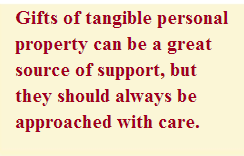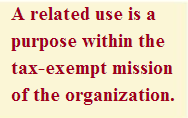Editor’s note: In this month’s installment of our nine-part series, we look at gift acceptance policies for gifts of tangible personal property.
When formulating policies to guide your organization in deciding which properties to encourage and accept as gifts, one of the most important areas you will want to examine is gifts of tangible personal property.
A broad category within the law, tangible personal property includes virtually any property you can touch or feel other than money, stocks and bonds, certificates of title, or other abstract representations of property (known as intangible personal property).
Examples of tangible personal property include coin and stamp collections, artwork, jewelry and antique furniture.
When given to your organization, such items can prove to be either “golden geese” or “white elephants,” so it is  important that you have policies in place to manage their acceptance and receipt.
important that you have policies in place to manage their acceptance and receipt.
Consider five areas of tax law of particular interest to any organization considering whether to accept a gift of tangible personal property:
For gifts valued at more than $5,000, the IRS requires a complete appraisal and the charity must report a sale of the property within three years of the date of the gift. Appraisal requirements are beyond the scope of this article, but should be examined closely prior to accepting all larger non-cash gifts other than certain securities. (See a recap of appraisal rules on Page 2.)
The ordinary income reduction rule under section 170 of the Internal Revenue Code reduces the value of the charitable deduction for tangible personal property to cost basis (usually original cost) for anyone who created the property or acquired it by gift from the creator. This most often applies to gifts of artwork.
The partial interest rule under section 170 denies a charitable contribution deduction under most circumstances for a gift of less than a person’s full ownership interest in tangible personal property.
An example would be the transfer of a painting while retaining the copyright interest in the artwork. Policies should forbid the acceptance of less than the complete ownership in such property without some indication that the donor is fully aware of any adverse tax consequences.
The future interest rule under section 170 specifies that a person may not transfer a future interest in tangible personal property and receive an income tax deduction.

For instance, consider the contribution of a painting to a charitable remainder trust. No deduction would be allowed. Policies should prohibit giving tangible personal property to any life income arrangement without full disclosure of tax consequences to the donor.
Finally, the related use rule under section 170 applies to virtually all outright and deferred gifts of tangible personal property.
Generally, tax deductions are limited for gifts of tangible personal property unless such gifts are put to a related use by the organization that receives the property. A related use is a purpose within the tax- exempt mission of the organization.
With some exceptions, if the property is put to an unrelated use (including immediate sale at auction or otherwise), the donor is allowed to deduct only his or her cost basis in the property. Some of the most embarrassing mistakes in charitable tax planning have been made in regard to receipt of property subject to related-use rules.
Employees, volunteers and agents should be forbidden from discussing with donors or making representations as to the use to which property will be put without approval from appropriate officers of the organization. Such a policy can prevent future head- aches when donors recount promises that led them to take a deduction that was later disallowed because of violation of the related-use rules. The same principles apply to appraisal requirements, the partial interest rule, the future interest rule and ordinary income reduction rule.
Gifts of tangible personal property can be a great source of support, but they should always be approached with care and the aid of competent volunteers or other advisors.

